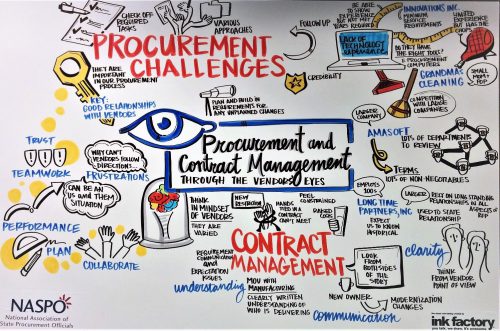NASPO recently held the REACH (Regional Education and Connection Hub) Conference in New Orleans, Louisiana. 270 state members representing 47 states and the District of Columbia came together to participate in the first “super regional” conference in NASPO’s history, bringing together the Southern, Eastern, Midwestern, and Western Regions. The event was filled with educational and professional growth opportunities that expanded NASPO members’ support network into all four regions. In this series of blogs, NASPO staff will share key takeaways and highlights from REACH’s expansive programs agenda.
“How many people have experienced frustration with a vendor?” Valerie Bollinger, State Purchasing Manager for the State of Idaho asked participants at a recent NASPO REACH conference. The room quickly filled with laughter as many state procurement professionals attending the breakout session titled Procurement and Contract Management Through the Vendor’s Eyes realized they can relate. Public procurement professionals and vendors alike are occasionally frustrated with each other and feel like it’s “them vs. us” when doing business together. The group exercise, led by Valerie, was an introspection and challenge to participants to put themselves in the vendor’s shoes and think through solutions that could inform better processes and relationships during the contract management phase, which is an important piece of the complex state procurement process.
Through a fun exercise using different vendor profiles and contract management scenarios, Valerie engaged participants in a group discussion about challenges and solutions to help states avoid pitfalls and improve the procurement process and contract management relationship with vendors.
Procurement offices around the country deal with vendors ranging from small mom-and-pop companies with limited technology experience to large, publicly-traded companies that are well-versed in doing business with state government. Common complaints procurement professionals hear from vendors relate to the procurement processes being too bureaucratic and time-consuming, having too many requirements, RFPs being too cumbersome and onerous, and many more. Some of the complaints are rooted in reality, and yes, there are solutions out there to many of them. Terms and conditions may be a factor that could impact competition, especially for IT contracts and small companies. Sometimes RFPs are long, and the procurement process can be time-consuming for both procurement professionals and vendors. However, the importance of having a fair public procurement process, robust contract management practices and good relationships with state government suppliers cannot be overstated. Poor or non-performance and unethical behaviors cannot be accepted by states. When doing business with vendors, because of ethical and accountability considerations, documenting everything to the letter of the law is of paramount importance in public procurement.

A few of the procurement process challenges experienced by vendors, as perceived by the state procurement professionals attending the breakout session, included new restrictions, not understanding requirements and expectations, non-negotiable terms, and overall communication barriers.
The session concluded with a few useful tips for public procurement officials and buyers to consider when doing business with vendors of all sizes:
- Try to consider the vendor’s perspective and experience when making decisions and setting policy
- Be mindful of the right balance between the state’s best interest and efficiency goals when considering open competition options for the available pool of vendors
- Evaluate current requirements/processes periodically and eliminate unnecessary barriers that can create challenges to potential bidders
- Make the solicitation process as easy as possible for vendors to maximize competition
- Put extra time and care in the early phase of solicitation development to avoid problems down the road such as scope creep
- Discuss expectations at the beginning of the contract
- Seek a balance between enforcing contractual requirements and making some allowance for price changes outside of the contractor’s control.
- Keep the lines of communication open
- Plan better and collaborate more
- Avoid the Us vs. Them
For NASPO recommended best practices and more useful tips on how to overcome barriers to effective contract management, as well as helpful checklists and templates check out the NASPO online Contract Administration Best Practices Guide.
Click here to download the complete PDF version of the Guide.
